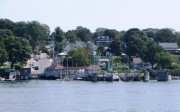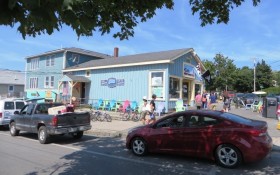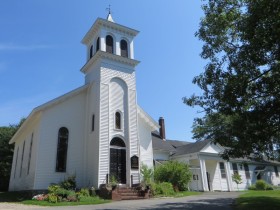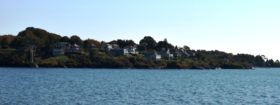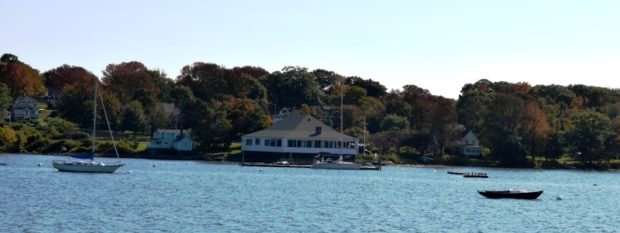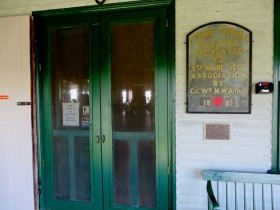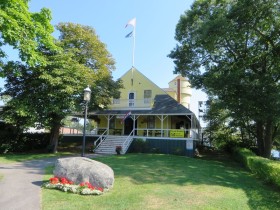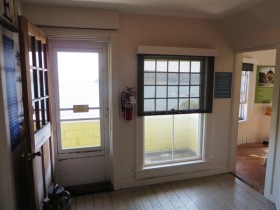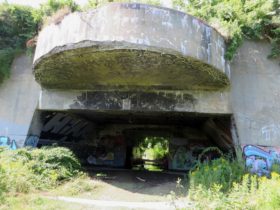
An informal Stone Art Site along Seashore Avenue (2014)
The Island is a City of Portland neighborhood in Casco Bay, accessible by ferry from the terminal on Portland’s waterfront. The brief trip carries freight, vehicles, bicycles and tourists. Little Diamond Island and Great Diamond Island are just to the west.
While the population is about 900, the number of people on this 720-acre island balloons to several thousand during the summer, including those making day trips.
Municipal facilities are typical of most villages in Maine, including its library, public safety and postal services on Island Avenue.
The building in center is the Trefethen Evergreen Improvement Association (TEIA)
It was built as the Dayburn Casino in 1914, – a- dancehall at Trefethen Landing. Now TEIA sponsors a range of summer activities: tennis, sailing, kid’s camp, dances, lectures, suppers, etc.
Maine’s participation in the Civil War is remembered and celebrated by the historical organizations of the Fifth and Eighth Maine Regiments. Their missions include World War II and Peaks Island history.
More Videos!
National Register of Historic Places
Battery Steele
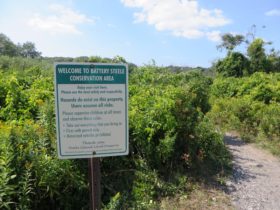 [Florida Avenue; N43° 39′ 31.38″ W70° 10′ 50.70″] Battery Steele represents the most advanced form of Coast Defense installation developed by the United States Army during World War II. It was armed with two 16-inch guns capable of firing a 2000 pound shot 26 miles. These were the largest, land based guns in the history of American Coastal Defenses, and represent the final development in the 170 year history of defending the Port of Portland and Casco Bay from naval attack. As an outer island in the bay with a clear view across the North Atlantic, Peaks Island was chosen as the principal site for Casco Bay’s defensive system.
[Florida Avenue; N43° 39′ 31.38″ W70° 10′ 50.70″] Battery Steele represents the most advanced form of Coast Defense installation developed by the United States Army during World War II. It was armed with two 16-inch guns capable of firing a 2000 pound shot 26 miles. These were the largest, land based guns in the history of American Coastal Defenses, and represent the final development in the 170 year history of defending the Port of Portland and Casco Bay from naval attack. As an outer island in the bay with a clear view across the North Atlantic, Peaks Island was chosen as the principal site for Casco Bay’s defensive system.
Although the guns, shields, carriages and accompanying controls were destroyed or removed after the war, Battery Steele remains otherwise intact and is an important relic of the end stage of American efforts to mount land based coastal defenses. Portland Harbor has been defended from an enemy naval attack since 1775 when it was burned by the British Navy. With independence the US Army assumed responsibility for its defense Fortifications were built or modernized in 1808, after the War of 1812, during the Civil War, in the 1870s, the 1890s and during World War I. Appropriations to build the new generation of fortifications were not approved until the eve of the Japanese attack on Pearl Harbor. The army and navy ranked Portland as the most important anchorage in the continental US because of its proximity to Europe.
Principal components of the new generation of defenses included secondary gun batteries of two 6 inch guns protected by steel shields and primary gun batteries of two 16 inch guns enclosed in concrete casements with steel shields covering the openings from which the guns projected. Both types of batteries featured structures built of heavily reinforced concrete which housed gun powder magazines, shell storage rooms, plotting, telephone switchboard and radio rooms, and electrical power plants. The 16 inch batteries had separate plotting, telephone switchboard, spotting, and radio rooms to protect the equipment from the blast of the guns. In 1942 the 16- inch battery was named in honor of Harry Lee Steele, 1874-1938, who rose to the rank of Major General and Chief of the Coast Artillery Corps. [Text edited and abridged from National Register of Historic Places. “Battery Steele.” http://npgallery.nps.gov/pdfhost/docs/nrhp/text/05001176.PDF]
Eighth Maine Regiment Memorial
[13 Eighth Main Avenue] The Eighth Maine Regiment Memorial building is a substantial and finely detailed Shingle Style structure built in 1891 by the Civil War veterans of the 8th Maine Regiment. Designed by the architectural firm of Fassett and Tompson, the shore-side building is located on the south side of Peaks Island. Intended to serve as the location of annual reunions, the building now functions as a memorial structure, museum, and lodging facility. It is owned by the Eighth Maine Regiment Association, the members of which are descendants of the Civil War veterans who served in one of the eleven companies of the Regiment.
The 8th Maine Regiment was one of the first ten Infantry Regiments organized and equipped by the State of Maine. The volunteer members were drawn from throughout the state and organized into eleven companies. Initially called to serve a three-year service the Regiment mustered in on September 7, 1861, and was finally discharged on January 18, 1866. The company had 1586 members enrolled, of which 134 were killed or died of wounds, 247 died of disease, 35 died in Confederate Prisons and 355 were wounded and survived.
During the four-and-a-half years that the Regiment served, they entered into eleven engagements, including several as part of the Petersburg Campaign and the Appomattox Campaign, before being present at Lee’s surrender at Appomattox on April 9, 1865. At the head of the Regiment were Col. William M. McArthur of Limington, and Lt. Col. Edward A True of Hope. In 1874 the 8th Regimental Association was formed and the group, open to all the veterans of the Regiment, started to hold annual reunions. The reunions, known as encampments, featured commemorative speeches, elaborate dinners, and communal accommodations meant to replicate, to a lesser extent, the collegiality the veterans experienced during their period of service, as well as to honor the memory of the men who had served and lost their lives. For the first sixteen years the encampments were held at varying locales throughout the state. However, in 1891 the association, with the generous help of Col. McArthur, erected the memorial building on Peaks Island.
Greenwood Garden Playhouse
The building that houses the Playhouse was built in 1884 as a roller skating rink. In addition to public roller skating, it featured a roller polo team, the Greenwoods, that was part of the Maine State Roller Derby league. In 1891 the building was converted into the Greenwood Garden Playhouse, the third of Peaks’ summer stock theaters Summer stock was performed there until the mid 1950s.
Today (2022) the Playhouse hosts an occasional play, concerts, recitals, the annual Lions Club variety show, dances, weddings, lobsterbakes and many other community events. As one of the last remaining historic recreation buildings on the island, it represents the island’s historic role as a summer destination for Portland residents. .
Many thanks to Kim MacIsaac of the Peaks Historical Society for her research and support for the Peaks article.


